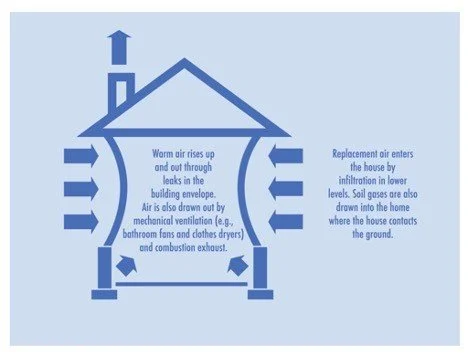A common misconception is that you don’t have radon gas or need to do radon testing in slab-on-grade homes. After all, it doesn’t have a basement, right? How could there possibly be radon gas entering your home?
Building-induced suction (courtesy: internachi.org)
One of the forces that drives radon gas into your home is what is called building-induced suction. Your home sucks, literally! Bathroom and kitchen exhaust vents, furnaces, water heaters, and clothes dryers all pull air from your home. In addition, weather, wind, and external temperature can affect the pressure in your home. Basically, your home acts like a chimney. Warm air in your home rises and leaks out of the building envelope. Soil gases and radon gases can be drawn into your home through the foundation, whether it is a slab on grade, a crawl space, or a full basement. That concrete slab is porous, may have cracks, and there are openings for plumbing, electrical, and other utilities.
The fact is that a home built on a slab puts you and your family closer to the source of radon gas. It’s like living in your basement. Radon gas enters your home where your slab comes into contact with the soil. Radon gas doesn’t care one bit if your home’s slab is at grade or 8 feet below grade.
Radon gas is not only found in basements.
Radon gas is colorless, odorless, and tasteless. Radon gas is naturally occurring as a byproduct of the breakdown of radium in the soils around and under your home. According to the US EPA, radon gas is the second-leading cause of lung cancer, right behind smoking.
Radon levels can be higher in homes with a basement because, in addition to the slab, you also have soil contact with the basement walls. The closer your living area is to the soil, the higher the potential for exposure to higher levels of radon gas.
For example, if you live in a home built on a full basement but spend most of your time living on the main floor and maybe sleeping upstairs, your exposure to radon gas is lower. Radon gas continues to break down after entering your home. It is also diluted and dissipates as it moves upward to the upper levels. If you live in a slab-on-grade home, you do not have that buffer, and that radon gas is entering right into your living space.
All homes have the potential for radon gas.
In Olmsted County and surrounding areas in Minnesota, 50% of the homes have elevated levels of radon gas. All homes are prone to radon gas, and no single home design or style is inherently better than another.
In 2009, codes required that all new homes be built radon-resistant. At a minimum, passive radon gas mitigation systems are in place. Simply put, this passive radon mitigation system, or radon gas-resistant system, will capture radon gas and route it safely from under your home to the atmosphere. Having a passive radon gas mitigation system in a home does not ensure that radon gas levels are not elevated. Even on a slab-on-grade home, the radon gas in the soil can be greater than what a passive radon gas mitigation system can remove from beneath the slab.
Testing is the only way to know your radon gas level.
Just because your home has a passive radon mitigation system does not mean you should not test or that radon gas levels are low in your slab-on-grade home.
For example, I built a slab-on-grade home in 2017. This home was built to be radon-resistant and had a passive radon mitigation system installed at construction. Over the course of a year, I tested the radon levels in the home in the spring, summer, fall, and winter. The radon gas levels in the home averaged anywhere from 3.2 p/Ci/l to 4.1 pCi/L (picocuries per liter), with winter having the highest radon gas levels and summer the lowest. We added a fan to the passive radon mitigation system to make it an active radon mitigation system. After installation, the winter radon gas average in the home was 0.8 pCi/L.
The action level for radon gas is 4.0 pCi/l or greater. This means that the EPA recommends the installation of a radon gas mitigation system to reduce radon gas levels in your home. It is not possible to reduce radon gas completely. For reference, the average radon gas level in the outside environment is 0.4 pCi/L.
Testing for radon gas with an electronic continuous radon monitor
Summary
Radon gas can enter your home regardless of the construction type, and measures should be taken to make your home radon gas resistant. The only way to know for sure is to test your home for radon gas levels. Radon gas testing can be added to any home inspection or performed as a stand-alone service.
At HomePro Inspections, our home inspectors are trained to inspect all areas of the home. Having a properly installed and maintained radon gas mitigation system will protect you and your family from unnecessary exposure to high radon gas levels. Any issues found are documented in your home inspection report and recommended for resolution by a qualified professional.
Visit our website to learn more or to schedule your home inspection in the Rochester, Owatonna, and Faribault, MN areas. You can contact us today at (507) 202-8942 or utilize our online “Schedule Now” feature to set up an appointment.


